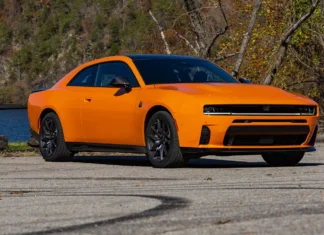
Trade tensions continue to escalate in light of recent tariff maneuvers by the Trump administration.
While the past several weeks have been a whirlwind of tariff threats and action on those threats, automakers are currently contending with a 25% import duty on all vehicles brought into the United states. However, nations targeted by these tariffs are not idly standing buy, with the Canadian government responding in kind by implementing their own, equal counter-tariff of 25% on vehicles imported from the U.S., effective at 12:01 AM Eastern Time this morning, April 9.
Clarifying point: This afternoon, President Trump announced a 90-day pause on the so-called “reciprocal tariffs” targeting virtually all goods from countries around the globe, which he enacted last week. That suspension does not impact the 25% automotive tariffs, which are still in effect at time of writing. If that situation changes, I’ll come back and post another update.
After an initial 30-day suspension of tariff actions on Canada and Mexico, this latest levy has a carve-out for vehicles imported to the U.S. that are compliant with the terms of the U.S.-Mexico-Canada Agreement (USMCA). Vehicles that are compliant with the terms of the USMCA won’t necessarily face the full tariff amount, though tariffs will still be applied to components of imported cars that don’t originate within North America. Vehicles that are not compliant with the USMCA, full stop, will face the full 25% import duty, which the importing automaker will pay at customs when vehicles reach U.S. ports of entry.

Depending on the automaker and the vehicle in question, when and how the costs of tariffs will be passed on to consumers varies. Some are taking a “let’s wait and see” approach before hiking prices, while others are offering temporary incentives to try and keep their sales figures up, before announcing they will indeed raise prices through additional import fees.
Of Canada’s decision to apply equal 25% tariffs to the United States, the country’s Finance Minister François-Philippe Champagne said in a statement: “These countermeasures will remain in place until the U.S. eliminates its tariffs against the Canadian automotive sector. The government is firmly committed to getting these U.S. tariffs removed as soon as possible, and will protect Canada’s workers, businesses, economy and industry.”
At the moment, it’s unclear how long the tariffs will remain in place. We could see another pause similar to the reciprocal tariffs pushed on April 2, or they could remain in place for years to come. If they do stay in place for long enough, customers will inevitably face higher prices at the dealer — moreso than they already are — with relatively few tariff-free alternatives. Even on U.S.-assembled vehicles, tariffs on parts imported from non-USMCA countries could mean higher sticker prices in a few months’ time. These counter-tariffs, as such, will hike prices for American and Canadian buyers alike, depending on the vehicles they want to purchase.























